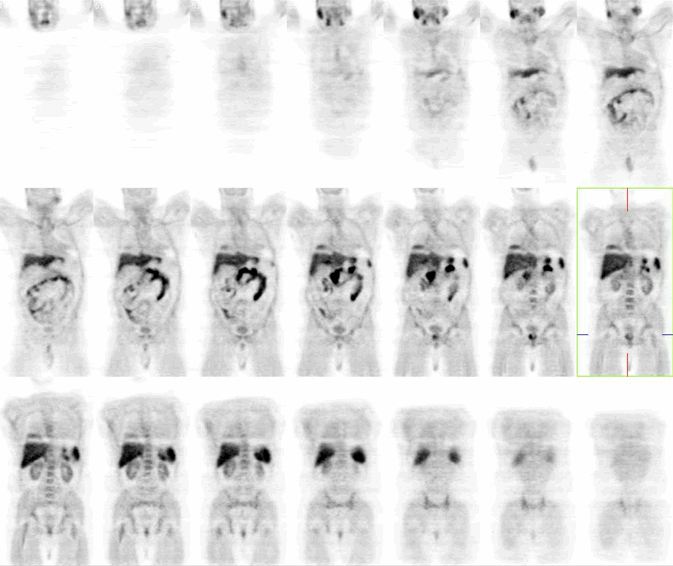Case Author(s): Xia Wang, M.D. and Barry A. Siegel, M.D. , 06/25/06 . Rating: #D3, #Q3
Diagnosis: Prostate Cancer
Brief history:
64-year-old man with recently diagnosed prostate cancer.
Images:

Coronal C-11 Acetate PET Images
View MIP cine in AVI format.
View main image(pt) in a separate image viewer
View second image().
Axial C-11 Acetate PET Images
Full history/Diagnosis is available below
Diagnosis: Prostate Cancer
Full history:
This is 64-year-old man with recently diagnosed prostate cancer (prostate specific antigen 71 ng/mL and Gleason 6). This study is performed as part of a research investigation of PET with C-11 acetate for initial staging of prostate cancer.
Radiopharmaceutical:
C-11 Acetate
Findings:
There is moderately increased C-11 acetate uptake within the right lateral lobe of the prostate gland, with a maximum standardized uptake value of 6.3. The CT portion of the examination demonstrates the prostate gland to be of normal size and configuration with no correlate on this noncontrast examination. No other regions of abnormally increased tracer uptake are identified.
Discussion:
C-11 acetate can act as a probe of tissue metabolism through entry into catabolic or anabolic metabolic pathways as mediated by acetyl–coenzyme A. C-11 acetate represents a new tracer for detection of prostate cancer with PET, measuring radiopharmaceutical uptake pathways that are different from those measured with F-18 FDG. Normal physiologic distributions include salivary glands, liver, spleen, pancreas, gastrointestinal tract, and kidneys, with minimal activity in the urinary bladder.
C-11 acetate showed marked uptake in prostate cancer and PET with this tracer is more sensitive in detection of prostate cancer than is FDG-PET. Preoperative staging of pelvic lymph nodes by conventional imaging techniques in prostate cancer is difficult. Studies have shown that C-11 choline PET is sensitive and accurate in preoperative staging of pelvic lymph nodes in prostate cancer and in evaluation of patients with rising PSA after radical prostatectomy or radiation therapy. Patients with rising prostate-specific antigen (PSA) levels after definitive local therapy of prostate carcinoma present a diagnostic dilemma. A local recurrence would be amenable to additional local therapy with curative intent, whereas metastatic disease would require palliative androgen ablation therapy. Preliminary data show that C-11 acetate also is a promising tracer for detection, staging and restaging of prostate cancer.
Reference:
Oyama N, Akino H, Kanamaru H, et al. 11C-Acetate PET Imaging of Prostate Cancer. J Nucl Med 2002; 43:181-186.
de Jong IJ, Pruim J, Elsinga PH, et al. Preoperative Staging of Pelvic Lymph Nodes in Prostate Cancer by 11C-Choline PET. J Nucl Med 2003; 44:331-335.
Oyama N, Miller TR, Dehdashti F, et al. 11C-Acetate PET Imaging of Prostate Cancer: Detection of Recurrent Disease at PSA Relapse. J Nucl Med 2003; 44:549-555.
Nuńez R, Macapinlac HA, Yeung HWD, et al. Combined 18F-FDG and 11C-Methionine PET Scans in Patients with Newly Progressive Metastatic Prostate Cancer. J Nucl Med 2002; 43:46-55.
Followup:
The patient underwent radical prostatectomy, which demonstrated adenocarcinoma involving the right base, right apex and left apex. There is no tumor present at prostatic surface. The seminal vesicles and pelvic lymph nodes are free of tumor.
Major teaching point(s):
C-11 acetate PET showed marked uptake in prostate cancer and is more sensitive in detection of prostate cancer than is FDG PET.
ACR Codes and Keywords:
References and General Discussion of PET Tumor Imaging Studies (Anatomic field:Genitourinary System, Category:Neoplasm, Neoplastic-like condition)
Search for similar cases.
Edit this case
Add comments about this case
Return to the Teaching File home page.
Case number: pt150
Copyright by Wash U MO

